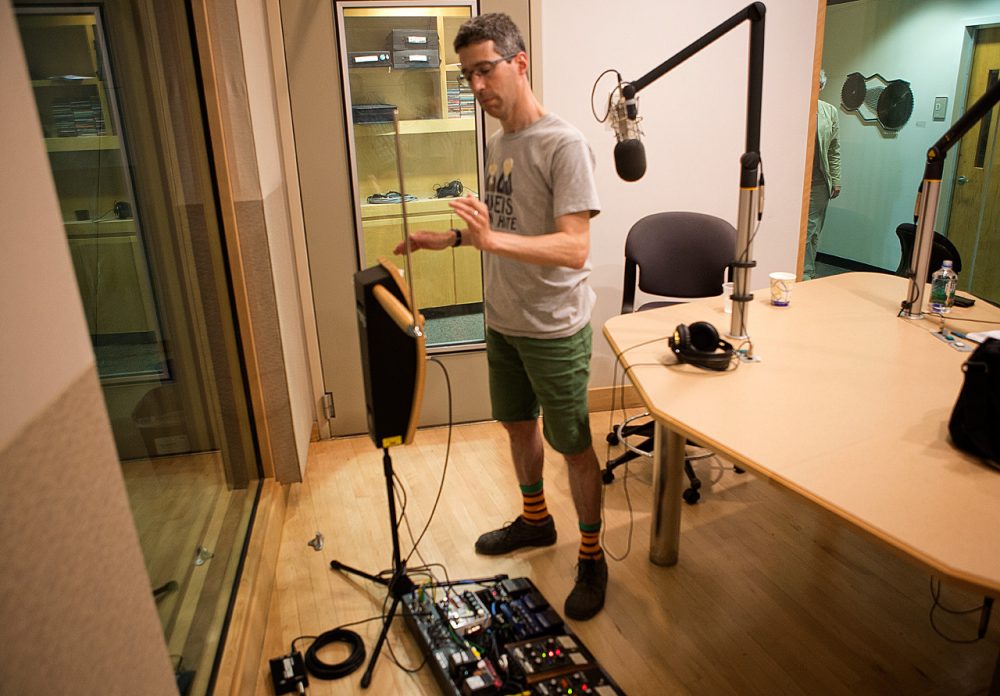Advertisement
The Ghostly Sound Of The Theremin, An Instrument Played Without Being Touched
Resume
Even if you're not familiar with the musical instrument called the theremin, chances are you've heard its ghostly sound.
It's featured in "Whole Lotta Love" by Led Zeppelin, as well as some of the band's other songs. A theremin-like instrument sometimes called the electro-theremin is used for one of the signature parts of "Good Vibrations" by The Beach Boys. And it’s a musical staple of science fiction movies.
The theremin is unique because of how it's played: you make music without touching it. How that's done will be demonstrated this Saturday at Porter Square Books in Cambridge by Somerville theremin player Jon Bernhardt. He'll be appearing with Montreal writer Sean Michaels, who has a new novel out, "Us Conductors," about the inventor of the theremin.
Bernhardt came to WBUR's studios this week and played his theremin during a conversation with All Things Considered host Sacha Pfeiffer. He described the instrument this way: "Typically it's a box of some sort with two antennae that come out of either side. One antenna controls the pitch and the other antenna controls the volume, and as you move your hands closer and farther away from the two antennae you control the sound of the instrument."
Playing a theremin is "very difficult," Bernhardt added, because the instrument is "very sensitive to your body movement. You could wiggle your pinky and the pitch could change by a major third. You could go from an open fist to a closed fist and you could be changing the pitch by an octave."
For physics nerds, here's Bernhardt explanation of the science behind the theremin: "Basically, your body is acting as a plate and a capacitor, so your body is sort of ground in a capacitor, and as you move your hand away from or closer to the antenna you're changing the capacitance, which in turn affects an inductor, which in turn affects an oscillator, and that controls the pitch."
"On more than one occasion when I've played the theremin," Bernhardt added, "people don't believe that it's the instrument. They think I'm humming secretly!"
"On more than one occasion when I've played the theremin, people don't believe it's the instrument. They think I'm humming secretly!"
Theremin player Jon Bernhardt
During his theremin performance at WBUR, Bernhardt — who became fascinated with the instrument after watching the documentary "Theremin: An Electric Odyssey" — narrated his movements: "As my hand moves closer to the antenna, the pitch gets higher. As I move my hand away from the antenna, the pitch gets lower. And similarly, with the volume, as my hand moves away from the volume antenna the pitch will get louder, and as it gets closer to the volume antenna the pitch gets softer until it's silent. And by manipulating these two antennae you can play melodies."
"Us Conductors," Michaels' part-biographical, part-fictional book about the theremin's inventor, Leon Theremin, also known as Lev Termen, is described by one reviewer as "an immigrant tale, an epic, a spy intrigue, a prison confession, an inventor's manual, a creation myth and an obituary."
Michaels summarizes his novel as "a dreaming of the story of Lev Termin, a Russian scientist who came to America as one of the acclaimed inventors of his day and fell head over heels in love with a beautiful young violinist before disappearing one night [and] returning to Russia, where he was banished to a Siberian gulag, where he lived out the next decade creating secret eavesdropping devices to spy on Americans, to spy on Stalin, and all the while dreaming of his lost love across the sea…It's a really mixed-up, glommed-up mix of historical fact and my own nonsense."
Michaels — who created one of the earliest music blogs, Said the Gramophone — says he owns "a couple of theremins" but his musical repertoire on the instrument is limited to "a version of 'Happy Birthday' that's probably roughly comprehensible as 'Happy Birthday' only if someone has a cake and I'm standing beside them!"
Listen above to WBUR's interview with Bernhardt and Michaels, which includes Bernhardt's in-studio theremin renditions of George Gershwin's "Summertime" and "Video Killed the Radio Star" by The Buggles.
This segment aired on June 20, 2014.

